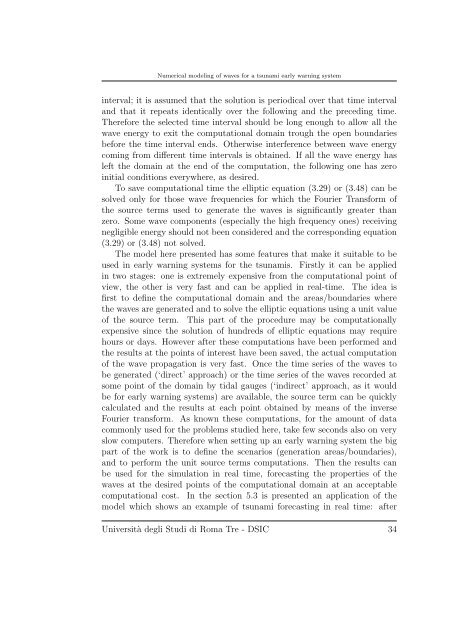Numerical modeling of waves for a tsunami early warning system
Numerical modeling of waves for a tsunami early warning system
Numerical modeling of waves for a tsunami early warning system
Create successful ePaper yourself
Turn your PDF publications into a flip-book with our unique Google optimized e-Paper software.
<strong>Numerical</strong> <strong>modeling</strong> <strong>of</strong> <strong>waves</strong> <strong>for</strong> a <strong>tsunami</strong> <strong>early</strong> <strong>warning</strong> <strong>system</strong><br />
interval; it is assumed that the solution is periodical over that time interval<br />
and that it repeats identically over the following and the preceding time.<br />
There<strong>for</strong>e the selected time interval should be long enough to allow all the<br />
wave energy to exit the computational domain trough the open boundaries<br />
be<strong>for</strong>e the time interval ends. Otherwise interference between wave energy<br />
coming from different time intervals is obtained. If all the wave energy has<br />
left the domain at the end <strong>of</strong> the computation, the following one has zero<br />
initial conditions everywhere, as desired.<br />
To save computational time the elliptic equation (3.29) or (3.48) can be<br />
solved only <strong>for</strong> those wave frequencies <strong>for</strong> which the Fourier Trans<strong>for</strong>m <strong>of</strong><br />
the source terms used to generate the <strong>waves</strong> is significantly greater than<br />
zero. Some wave components (especially the high frequency ones) receiving<br />
negligible energy should not been considered and the corresponding equation<br />
(3.29) or (3.48) not solved.<br />
The model here presented has some features that make it suitable to be<br />
used in <strong>early</strong> <strong>warning</strong> <strong>system</strong>s <strong>for</strong> the <strong>tsunami</strong>s. Firstly it can be applied<br />
in two stages: one is extremely expensive from the computational point <strong>of</strong><br />
view, the other is very fast and can be applied in real-time. The idea is<br />
first to define the computational domain and the areas/boundaries where<br />
the <strong>waves</strong> are generated and to solve the elliptic equations using a unit value<br />
<strong>of</strong> the source term. This part <strong>of</strong> the procedure may be computationally<br />
expensive since the solution <strong>of</strong> hundreds <strong>of</strong> elliptic equations may require<br />
hours or days. However after these computations have been per<strong>for</strong>med and<br />
the results at the points <strong>of</strong> interest have been saved, the actual computation<br />
<strong>of</strong> the wave propagation is very fast. Once the time series <strong>of</strong> the <strong>waves</strong> to<br />
be generated (‘direct’ approach) or the time series <strong>of</strong> the <strong>waves</strong> recorded at<br />
some point <strong>of</strong> the domain by tidal gauges (‘indirect’ approach, as it would<br />
be <strong>for</strong> <strong>early</strong> <strong>warning</strong> <strong>system</strong>s) are available, the source term can be quickly<br />
calculated and the results at each point obtained by means <strong>of</strong> the inverse<br />
Fourier trans<strong>for</strong>m. As known these computations, <strong>for</strong> the amount <strong>of</strong> data<br />
commonly used <strong>for</strong> the problems studied here, take few seconds also on very<br />
slow computers. There<strong>for</strong>e when setting up an <strong>early</strong> <strong>warning</strong> <strong>system</strong> the big<br />
part <strong>of</strong> the work is to define the scenarios (generation areas/boundaries),<br />
and to per<strong>for</strong>m the unit source terms computations. Then the results can<br />
be used <strong>for</strong> the simulation in real time, <strong>for</strong>ecasting the properties <strong>of</strong> the<br />
<strong>waves</strong> at the desired points <strong>of</strong> the computational domain at an acceptable<br />
computational cost. In the section 5.3 is presented an application <strong>of</strong> the<br />
model which shows an example <strong>of</strong> <strong>tsunami</strong> <strong>for</strong>ecasting in real time: after<br />
Università degli Studi di Roma Tre - DSIC 34

















